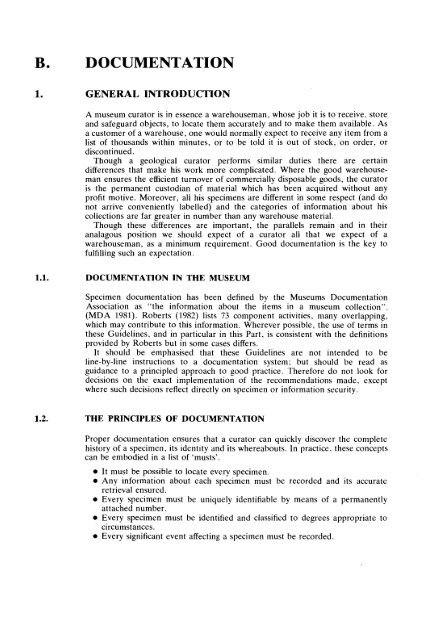GUIDELINES FOR THE CURATION OF GEOLOGICAL MATERIALS
GUIDELINES FOR THE CURATION OF GEOLOGICAL MATERIALS
GUIDELINES FOR THE CURATION OF GEOLOGICAL MATERIALS
Create successful ePaper yourself
Turn your PDF publications into a flip-book with our unique Google optimized e-Paper software.
DOCUMENTATION<br />
GENERAL INTRODUCTION<br />
A museum curator is in essence a warehouseman, whose job it is to receive, store<br />
and safeguard objects, to locate them accurately and to make them available. As<br />
a customer of a warehouse, one would normally expect to receive any item from a<br />
list of thousands within minutes, or to be told it is out of stock, on order, or<br />
discontinued.<br />
Though a geological curator performs similar duties there are certain<br />
differences that make his work more complicated. Where the good warehouseman<br />
ensures the efficient turnover of commercially disposable goods, the curator<br />
is the permanent custodian of material which has been acquired without any<br />
profit motive. Moreover, all his specimens are different in some respect (and do<br />
not arrive conveniently labelled) and the categories of information about his<br />
collections are far greater in number than any warehouse material.<br />
Though these differences are important, the parallels remain and in their<br />
analagous position we should expect of a curator all that we expect of a<br />
warehouseman, as a minimum requirement. Good documentation is the key to<br />
fulfilling such an expectation.<br />
DOCUMENTATION IN <strong>THE</strong> MUSEUM<br />
Specimen documentation has been defined by the Museums Documentation<br />
Association as "the information about the items in a museum collection".<br />
(MDA 1981). Roberts (1982) lists 73 component activities, many overlapping,<br />
which may contribute to this information. Wherever possible, the use of terms in<br />
these Guidelines, and in particular in this Part, is consistent with the definitions<br />
provided by Roberts but in some cases differs.<br />
It should be emphasised that these Guidelines are not intended to be<br />
line-by-line instructions to a documentation system; but should be read as<br />
guidance to a principled approach to good practice. Therefore do not look for<br />
decisions on the exact implementation of the recommendations made, except<br />
where such decisions reflect directly on specimen or information security.<br />
<strong>THE</strong> PRINCIPLES <strong>OF</strong> DOCUMENTATION<br />
Proper documentation ensures that a curator can quickly discover the complete<br />
history of a specimen, its identity and its whereabouts. In practice, these concepts<br />
can be embodied in a list of 'musts'.<br />
It must be possible to locate every specimen.<br />
Any information about each specimen must be recorded and its accurate<br />
retrieval ensured.<br />
Every specimen must be uniquely identifiable by means of a permanently<br />
attached number.<br />
Every specimen must be identified and classified to degrees appropriate to<br />
circumstances.<br />
Every significant event affecting a specimen must be recorded.

















